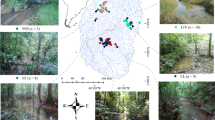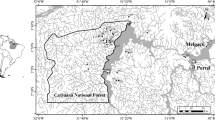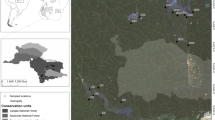Abstract
The influence of forest fragmentation (habitat isolation) on biological and ecological diversity of aquatic insects was investigated in streams of fragmented forests in Hulu Gombak (6 streams) and Gunung Angsi (5 streams) and un-fragmented forest of Berembun (6 streams) in peninsular Malaysia. Several environmental parameters including canopy cover, DO, temperature and pH differed significantly among the three catchments (P < 0.05). We found that taxonomic richness in Berembun forest was significantly different from Gunung Angsi (P < 0.05), but not with Hulu Gombak forests (P > 0.05). Nestedness pattern that measures the effect of habitat isolation on taxonomic assemblages showed that aquatic insect’s community in un-fragmented forest (Berembun) was less nested (T = 54.4), indicating high diversity compared to highly nested (less diverse) in the two fragmented forests (Hulu Gombak, T = 30.45 and Gunung Angsi, T = 35.45). Taxa similarity in Berembun streams was negatively correlated with the geographical distance among streams (Mantel test, r = − 0.462, P < 0.05). Such correlation was absent in both Gunung Angsi and Hulu Gombak streams. Forest fragmentation in Hulu Gombak and Gunung Angsi measured as the distance of the forests from the nearest forested area had negative effect on aquatic insects diversity (r 2 = − 0.149, P < 0.05), but not on their abundances (r 2 = 0.003, P > 0.05). We concluded that local habitat conditions were the most important in shaping the aquatic insects community among streams of both unfragmented and fragmented forests.



Similar content being viewed by others
References
Ali AB, Ahmad M (1988) Water quality in rice fields and sump ponds and its relationship to phytoplankton growth in rice field fish culture system. Trop Ecol 29:63–70
Al-Shami SA, Md Rawi CS, Ahmad AH, Abdul Hamid S, Mohd Nor SA (2011) Influence of agricultural, industrial, and anthropogenic stresses on the distribution and diversity of macroinvertebrates in Juru River Basin, Penang, Malaysia. Ecotox Environ Safe 74:1195–1202
Andren H (1994) Effects of habitat fragmentation on birds and mammals in landscapes with different proportions of suitable habitat: a review. Oikos 71:355–366
Atmar W, Patterson BD (1993) The measure of order and disorder in the distribution of species in fragmented habitat. Oecologia 96:373–382
Azhar B, Lindenmayer DB, Wood J, Fischer J, Manning A, McElhinny C, Zakaria M (2011) The conservation value of oil palm plantation estates, smallholdings and logged peat swamp forest for birds. Forest Ecol Manag 262:2306–2315
Azrina M, Yap C, Rahim Ismail A, Ismail A, Tan S (2006) Anthropogenic impacts on the distribution and biodiversity of benthic macroinvertebrates and water quality of the Langat River, Peninsular Malaysia. Ecotox Environ Safe 64:337–347
Barbour MT, Gerritsen J, Snyder BD, Stribling JB (1999) Rapid bioassessment protocols for use in streams and wadeable rivers: periphyton, benthic macroinvertebrates and fish, 2nd edn. EPA 841-B-99-002. USEPA, Office of Water, Washington, DC
Boyero L, Pearson RG, Camacho R (2006) Leaf breakdown in Australian tropical streams: the role of different species in ecosystem functioning. Arch Hydrobiol 166:453–466
Boyero L, Ramirez A, Dudgeon D, Pearson RG (2009) Are tropical streams really different? J N Am Benthol Soc 28:397–403
Boyero L, Pearson RG, Dudgeon D, Ferreira V, Graça MAS, Gessner MO, Boulton AJ, Chauvet E, Yule CM, Albariño RJ, Ramírez A, Helson JE, Callisto M, Arunachalam M, Chará J, Figueroa R, Mathooko JM, Gonçalves JF Jr, Moretti MS, Chará-Serna AM, Davies JN, Encalada A, Lamothe S, Buria LM, Castela J, Cornejo A, Li AOY, M’Erimba C, Villanueva VD, del Carmen Zúñiga M, Swan CM, Barmuta LA (2011) Global patterns of stream detritivore distribution: implications for biodiversity loss in changing climates. Global Ecol Biogeogr 21:134–141
Brown JH, Kodric-Brown A (1977) Turnover rates in insular biogeography: effect of immigration on extinction. Ecology 58(2):445–449
Chase JM (2003) Community assembly: when should history matter? Oecologia 136:489–498
Corley RHV (2009) How much palm oil do we need? Environ Sci Policy 12:134–139
Delong MD, Brusven MA (1998) Macroinvertebrate community structure along the longitudinal gradient of an agriculturally impacted stream. Environ Manage 22:445–457
Douglas I, Spencer T, Greer T, Bidin K, Sinun W, Meng WW (1992) The impact of selective commercial logging on stream hydrology, chemistry and sediment loads in the Ulu Segama rain-forest, Sabah, Malaysia. Philos T R Soc B 335:397–406
Dudgeon D (2006) The impacts of human disturbance on stream benthic invertebrates and their drift in North Sulawesi, Indonesia. Freshw Biol 51:1710–1729
Dudgeon D (2008) Tropical streams ecology. Elsevier, North Holland
Dudgeon D (2010) Prospects for sustaining freshwater biodiversity in the 21st century: linking ecosystem structure and function. Curr Opin Environ Sustain 2:422–430
Eikaas HS, Harding JS, Kliskey AD, Mcintosh AR (2005) The effect of terrestrial habitat fragmentation on fish populations in small streams: a case study from New Zealand. Nor Geogr Tidsskr 59:269–275
Elliott JM (1971) Some methods for the statistical analysis of samples of benthic invertebrates. Freshwater Biological Association, Ambleside
Fahrig L (2003) Effects of habitat fragmentation on biodiversity. Annu Rev Ecol Evol Syst 34:487–515
Fitzherbert EB, Struebig MJ, Morel A, Danielsen F, Bruhl CA, Donald PF, Phalan B (2008) How will oil palm expansion affect biodiversity? Trends Ecol Evol 23:538–545
Forbes AE, Chase JM (2002) The role of habitat connectivity and landscape geometry in experimental zooplankton metacommunities. Oikos 96:433–440
Gonzalez A, Lawton J, Gilbert F, Blackburn T, Evans-Freke I (1998) Metapopulation dynamics, abundance, and distribution in a microecosystem. Science 281:2045–2047
Gopal B (2005) Does inland aquatic biodiversity have a future in Asian developing countries? Hydrobiologia 542:69–75
Gucker B, Boechat IG, Giani A (2009) Impacts of agricultural land use on ecosystem structure and whole-stream metabolism of tropical Cerrado streams. Freshw Biol 54:2069–2085
Hamid SA, Rawi CSM (2011) Influence of substrate embeddedness and canopy cover on the distribution of Ephemeroptera, Plecoptera and Trichoptera (EPT) in tropical rivers. Aquat Insects 33:281–292
Heino J (2005) Functional biodiversity of macroinvertebrate assemblages along major ecological gradients of boreal headwater streams. Freshw Biol 50:1578–1587
Heino J (2009) Biodiversity of aquatic insects: spatial gradients and environmental correlates of assemblage-level measures at large scales. Freshw Rev 2:1–29
Heino J (2011) A macroecological perspective of diversity patterns in the freshwater realm. Freshw Biol 56:1703–1722
Heino J, Muotka T (2005) Highly nested snail and clam assemblages in boreal lake littorals: roles of isolation, area, and habitat suitability. Ecoscience 12:141–146
Heino J, Soininen J (2007) Are higher taxa adequate surrogates for species-level assemblage patterns and species richness in stream organisms? Biol Conserv 137:78–89
Heino J, Ilmonen J, Kotanen J, Mykra H, Paasivirta L, Soininen J, Virtanen R (2009) Surveying biodiversity in protected and managed areas: algae, macrophytes and macroinvertebrates in boreal forest streams. Ecol Indic 9:1179–1187
Heino J, MykrÄ H, Rintala J (2010) Assessing patterns of nestedness in stream insect assemblages along environmental gradients. Ecoscience 17:345–355
Hoyle M, Gilbert F (2004) Species richness of moss landscapes unaffected by short-term fragmentation. Oikos 105:359–367
Hulten E (1937) Outline of the history of arctic and boreal biota during the quaternary period. Thule, Stockholm
Ims RA, Petter Leinaas H, Coulson S (2004) Spatial and temporal variation in patch occupancy and population density in a model system of an arctic Collembola species assemblage. Oikos 105:89–100
Iwata T, Nakano S, Inoue M (2003) Impacts of past riparian deforestation on stream communities in a tropical rain forest in Borneo. Ecol Appl 13:461–473
Kasangaki A, Chapman LJ, Balirwa J (2008) Land use and the ecology of benthic macroinvertebrate assemblages of high-altitude rainforest streams in Uganda. Freshw Biol 53:681–697
Kneitel JM, Miller TE (2003) Dispersal rates affect species composition in metacommunities of Sarracenia purpurea inquilines. Am Nat 162:165–171
Koh LP, Wilcove DS (2008) Is oil palm agriculture really destroying tropical biodiversity? Conserv Lett 1:60–64
Larsen S, Ormerod SJ (2010) Combined effects of habitat modification on trait composition and species nestedness in river invertebrates. Biol Conserv 143:2638–2646
Lorion CM, Kennedy BP (2009) Relationships between deforestation, riparian forest buffers and benthic macroinvertebrates in neotropical headwater streams. Freshw Biol 54:165–180
Magurran AE (1988) Ecological diversity and its measurement. Princeton University Press, Princeton
Malmqvist B, Zhang Y, Adler PH (1999) Diversity, distribution and larval habitats of North Swedish blackflies (Diptera: Simuliidae). Freshw Biol 42:301–314
Mantel N (1967) The detection of disease clustering and generalized regression approach. Cancer Res 27:209–220
McCune B, Grace JB (2002) Analysis of ecological communities. MjM Software, Oregon
Merritt RW, Cummins KW (1996) An introduction to the aquatic insects of North America. Kendall Hunt, Dubuque
Monaghan MT, Robinson CT, Spaak P, Ward JV (2005) Macroinvertebrate diversity in fragmented Alpine streams: implications for freshwater conservation. Aquat Sci 67:454–464
Mori T, Murakami M, Saitoh T (2010) Latitudinal gradients in stream invertebrate assemblages at a regional scale on Hokkaido Island, Japan. Freshw Biol 55:1520–1532
Morse JC, Yang L, Tian L (1994) Aquatic insects of China useful for monitoring water quality. Hohai University Press, Nanjing
Mouquet N, Loreau M (2003) Community patterns in source-sink metacommunities. Am Nat 162:544–557
Negishi JN, Sidle RC, Noguchi S, Nik AR, Stanforth R (2006) Ecological roles of roadside fern (Dicranopteris curranii) on logging road recovery in Peninsular Malaysia: preliminary results. For Ecol Manag 224:176–186
Ostman Ö, Kneitel JM, Chase JM (2006) Disturbance alters habitat isolation’s effect on biodiversity in aquatic microcosms. Oikos 114:360–366
Patterson BD, Atmar W (1986) Nested subsets and the structure of insular mammalian faunas and archipelagos. Biol J Linn Soc 28:65–82
Seaby RM, Henderson PA (2006) Species diversity and richness version 4. Pisces Conservation Ltd., Lymington
Sodhi NS, Brook BW (2006) Southeast Asian biodiversity in crisis. Cambridge University Press, Cambridge
Song MY, Leprieur F, Thomas A, Lek-Ang S, Chon TS, Lek S (2009) Impact of agricultural land use on aquatic insect assemblages in the Garonne river catchment (SW France). Aquat Ecol 43:999–1009
Strayer DL, Dudgeon D (2010) Freshwater biodiversity conservation: recent progress and future challenges. J N Am Benthol Soc 29:344–358
Urban MC (2004) Disturbance heterogeneity determines freshwater metacommunity structure. Ecology 85:2971–2978
Wantzen KM (2006) Physical pollution: effects of gully erosion on benthic invertebrates in a tropical clear-water stream. Aquat Conserv 16:733–749
Whittaker RH (1960) Vegetation of the Siskiyou mountains, Oregon and California. Ecol Monogr 30:280–338
Wilcove DS, Koh LP (2010) Addressing the threats to biodiversity from oil-palm agriculture. Biodivers Conserv 19:999–1007
Yule C, Yong H (2004) Freshwater invertebrates of the Malaysian region. Akademi Sains Malaysia, Kuala Lumpur
Acknowledgments
We express our heartfelt gratitude to various people involved in this study; Hazdri Abdullah, Mohd Shukri, Hamzah, Siti Khatijah, Yahya Tahir, Wan Zaki, Kalimuthu for their tireless help in the field. To many others who are directly or indirectly helping us during this study, we are deemed indebted. We are grateful to the Dean, School of Biological Sciences, Universiti Sains Malaysia in Penang, for providing field and laboratory facilities to conduct this research. To Forest Research Institute Malaysia counterparts headed by Dr Christine Fletcher and Dr Abdul Rahman Kassim, we thank them for their financial support, help and understanding. The Conservation of Biodiversity (CBioD) Project is a national project executed by the Ministry of Natural Resources and the Environment and implemented by the Forest Research Institute Malaysia. The CBioD Project is co-funded by the UNDP-GEF (MAL/04/G3) and ITTO [PD 165 02 Rev.3 (F)]. Key partners to the CBioD Project are Perak ITC S/B, Perak SEDC, Forestry Headquarters and State Forestry Departments of Peninsular Malaysia. The project is a joint effort with the University of Miami, Duke University and Harvard University. Thanks for three anonymous reviewers and the handling editor for their constructive comments and suggestions which improve the paper significantly.
Author information
Authors and Affiliations
Corresponding author
Additional information
Handling Editor: Michael T. Monaghan
Electronic supplementary material
Below is the link to the electronic supplementary material.
Rights and permissions
About this article
Cite this article
Md Rawi, C.S., Al-Shami, S.A., Madrus, M.R. et al. Local effects of forest fragmentation on diversity of aquatic insects in tropical forest streams: implications for biological conservation. Aquat Ecol 47, 75–85 (2013). https://doi.org/10.1007/s10452-012-9426-8
Received:
Accepted:
Published:
Issue Date:
DOI: https://doi.org/10.1007/s10452-012-9426-8




